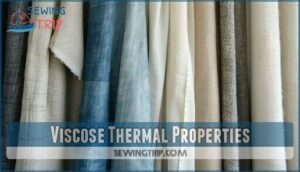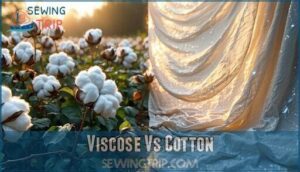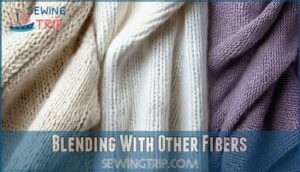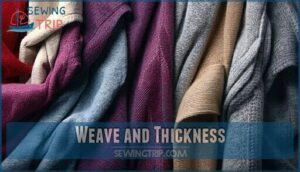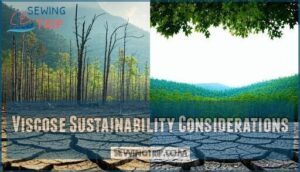This site is supported by our readers. We may earn a commission, at no cost to you, if you purchase through links.
 Viscose isn’t warm to wear – it’s actually quite cooling. This semi-synthetic fabric breathes like cotton but wicks moisture even better, making it perfect for hot days when you need something that won’t stick to your skin.
Viscose isn’t warm to wear – it’s actually quite cooling. This semi-synthetic fabric breathes like cotton but wicks moisture even better, making it perfect for hot days when you need something that won’t stick to your skin.
Think of viscose as your fabric friend for staying comfortable, not cozy. It’s lightweight, flows with air movement, and helps sweat evaporate quickly.
While it won’t keep you toasty like wool or fleece, that’s exactly why fashion lovers reach for viscose blouses and dresses when temperatures climb. The fabric’s silky feel and cooling properties make it ideal for warm weather, though layering can help bridge seasonal gaps.
Table Of Contents
Key Takeaways
- You’ll feel cooler, not warmer – Viscose’s breathable structure and moisture-wicking properties actually have a cooling effect on your skin, making it unsuitable for staying warm
- It’s perfect for hot weather wear – The fabric excels in summer conditions by absorbing up to 14% of its weight in moisture and allowing excellent airflow to prevent overheating
- You’ll need layers for cold weather – Viscose alone won’t provide adequate insulation in winter – you’ll need to pair it with wool, fleece, or other warming materials for proper thermal protection
- Blends and weave density affect warmth – While pure viscose stays cool, mixing it with wool or polyester and choosing thicker weaves can improve its heat retention properties
Viscose Fabric Overview
If you’ve ever wondered whether that silky-smooth viscose blouse will keep you cozy or leave you chilly, you’re not alone.
This semi-synthetic fabric, created from wood pulp back in 1883 as an affordable silk alternative, has unique thermal properties that might surprise you.
This wood-pulp wonder from 1883 packs cooling surprises that defy expectations.
History of Viscose
The tale of viscose begins in 1883 when scientists first created artificial silk as a budget-friendly alternative to expensive natural silk.
This cellulose-based fiber revolutionized textile manufacturing through three key milestones:
- Early Patents – Initial fiber development focused on replicating silk’s luxurious feel
- Commercial Production – Large-scale rayon manufacturing launched in Europe by 1905
- Global Expansion – Widespread adoption transformed the textile industry worldwide
Manufacturing Process
Viscose manufacturing transforms wood chips into textile gold through an intricate chemical process.
Pulp sourcing begins with extracting cellulose from eucalyptus or pine trees using harsh chemicals like sodium hydroxide.
The viscose solution gets forced through spinnerets, creating silky fibers in sulfuric acid baths.
Modern closed-loop systems and the Lyocell process dramatically improve waste reduction, making textile manufacturing cleaner than traditional methods, which is a significant improvement for textile gold.
Composition and Structure
Understanding cellulose source and molecular structure helps explain viscose fabric warmth properties.
Wood pulp undergoes chemical processing to break down cellulose fibers, creating a unique fiber arrangement that affects absorbency levels.
This viscose insulation stems from cellulose molecules forming loose chains, allowing air circulation.
The viscose warmth factor depends on this open structure, making viscose fabric properties ideal for breathability rather than heat retention.
Is Viscose Warm to Wear

The short answer? No, viscose isn’t particularly warm to wear. This semi-synthetic fabric actually keeps you cooler than you might expect.
Viscose feels cool against your skin, not cozy—think breathable summer fabric, not winter warmth.
Viscose warmth depends largely on your activity level and the weather. The fabric’s structure allows excellent air circulation, making viscose clothing warmth relatively low compared to wool or fleece. You’ll find viscose for cold weather isn’t ideal on its own – it lacks the insulation properties needed for winter temperatures.
Climate suitability becomes essential when choosing viscose garments. The fabric excels in warm conditions but falls short when temperatures drop. Viscose comfort comes from its breathable nature, not thermal protection. Is viscose warm? Only marginally.
Layering viscose offers a practical solution for cooler days. You can wear viscose pieces as base layers under warmer materials, combining comfort with necessary insulation. Viscose winter wear works best when paired with wool sweaters, down jackets, or other insulating fabrics. Viscose also boasts decent breathability levels, which helps to keep you cool.
The fabric’s cooling properties make it perfect for summer but require strategic viscose insulation through layering during colder months.
Viscose Thermal Properties
Understanding viscose’s thermal properties helps you make smart clothing choices for different weather conditions. These characteristics determine whether you’ll stay comfortable or feel too hot in your viscose garments.
Breathability and Moisture Absorption
Your body will thank you for choosing viscose’s exceptional moisture wicking abilities.
This fabric absorbs up to 14% of its weight in sweat, preventing that sticky feeling synthetic materials create.
With air permeability exceeding 400 mm/s, viscose breathability delivers impressive cooling effects.
The hydrophilic structure pulls moisture from your skin to the fabric surface, enhancing sweat absorption and overall fabric comfort for superior viscose temperature regulation.
Heat Retention and Insulation
When considering viscose warmth rating, you’ll find this fabric offers moderate insulation at best.
Viscose insulation properties fall short compared to traditional warming materials, with CLO values ranging from 0.06 to 0.11.
Here’s what affects viscose fabric warmth:
- Fiber heat capacity – Lower than wool, releasing heat quickly rather than trapping it
- Weave density effects – Cross-miss knits provide better insulation than loose weaves
- Blended fabric warmth – Mixing with polyester or wool improves heat retention
- Fabric insulation – Thicker viscose holds more warmth but still lags behind wool
- Viscose layering strategies – Essential for adequate cold-weather protection
Is viscose warm to wear? Not particularly.
You’ll need smart layering for real warmth.
It’s often used as a low-cost silk alternative.
Comparison to Natural Fibers
Comparing viscose fabric warmth to natural fibers reveals fascinating differences.
Cotton offers superior breathability but similar moisture absorption, while wool provides better insulation across temperature ranges.
Silk matches viscose’s drape but lacks its affordability, and linen excels in hot climates with faster evaporation.
This fabric is categorized as regenerated cellulose, being neither fully natural nor synthetic.
| Fiber | Warmth Level | Best Climate |
|---|---|---|
| Cotton | Moderate | Warm weather |
| Wool | High | Cold/variable |
| Viscose | Low-moderate | Seasonal |
Viscose Vs Other Fabrics
You’ll want to know how viscose stacks up against other fabrics when choosing clothes for different weather conditions.
Understanding these comparisons helps you make smarter wardrobe decisions based on warmth, breathability, and comfort needs.
Viscose Vs Polyester
Two key differences separate viscose from polyester when you’re choosing warm clothing.
Viscose breathability keeps you cool through superior moisture absorption, while polyester warmth comes from heat-trapping synthetic fibers that resist moisture.
| Feature | Viscose | Polyester |
|---|---|---|
| Warmth Level | Low heat retention, cooling effect | High heat retention, insulating |
| Moisture Management | Absorbs 11-14% weight in moisture | Water-resistant, quick-drying |
| Breathability | Excellent airflow, prevents overheating | Limited breathability, traps heat |
| Durability | Delicate, prone to stretching when wet | Strong, maintains shape after washing |
| Environmental Impact | Biodegradable but chemical-intensive production | Non-biodegradable, petroleum-based |
For winter wear, polyester clearly wins the durability differences battle and cost comparison favors its longevity.
However, viscose material warmth works better for layering since it won’t overheat you indoors.
Viscose Vs Cotton
Cotton and viscose differ substantially in thermal regulation and fiber properties.
Cotton’s natural breathability excels in hot weather, while viscose offers superior absorbency comparison with 11-16% moisture regain versus cotton’s 7-11%.
Both materials provide moderate warmth, but weave differences affect their clothing applications in cold weather scenarios.
| Property | Cotton | Viscose |
|---|---|---|
| Breathability | High airflow | Moderate airflow |
| Moisture Absorption | 7-11% weight | 11-16% weight |
| Thermal Feel | Balanced warmth | Cool to touch |
Cotton wins for durability and cost analysis, while viscose material warmth depends on blending and thickness.
Viscose Vs Wool
Wool reigns supreme in the warmth comparison, offering superior insulation that viscose simply can’t match.
You’ll find viscose’s breathability and moisture management excel in warmer conditions, while wool traps heat effectively for cold weather protection.
| Feature | Viscose | Wool |
|---|---|---|
| Warmth | Minimal insulation | Excellent heat retention |
| Moisture | Quick absorption/release | Natural wicking properties |
| Cost | Budget-friendly option | Premium investment piece |
Factors Affecting Viscose Warmth
While viscose naturally feels cool and breathable, several factors can dramatically change how warm the fabric actually feels against your skin.
The blend composition, fabric construction, and finishing treatments all play pivotal roles in determining whether your viscose garment will keep you comfortable or leave you shivering.
Blending With Other Fibers
Blending viscose with other fibers transforms its warmth properties dramatically.
When you combine viscose with wool, you’ll get enhanced insulation while maintaining softness—perfect for winter garments.
Cotton-viscose blends offer moderate warmth with improved breathability.
Polyester additions boost thermal retention substantially.
Performance enhancement occurs through strategic fabric blending, creating texture variations that affect heat retention.
These viscose blend warmth combinations provide cost reduction compared to pure wool while offering weave compatibility across different garment types, with superior dyeing effects.
Weave and Thickness
Within viscose’s structure, fabric density and knit structures dramatically influence warmth levels.
Thicker weaves trap more air, creating natural insulation that transforms lightweight viscose into surprisingly cozy cold weather gear.
- Cross miss weaves provide 16.18% insulation rate – highest warmth retention
- Single jersey knits offer 12.98% insulation with balanced breathability
- Twill woven types deliver moderate warmth at 12.37% insulation
- Complex fiber weight structures create more air pockets for heat retention
- Layering effects multiply when combining dense viscose with other fabrics
Treatment and Finishing
Finishing treatments dramatically alter viscose’s thermal properties through chemical additives and surface modifications.
Softening agents can trap air between fibers, creating insulation pockets that boost warmth. Wrinkle resistance treatments often involve chemical coatings that reduce breathability, making you feel warmer.
Dyeing techniques and fabric finishing processes can compact or loosen the fiber structure, directly impacting heat retention and moisture-wicking capabilities.
Caring for Viscose Clothing
Your viscose clothes need special care to maintain their shape and softness, but don’t worry—it’s easier than you think.
With the right washing techniques and storage methods, you’ll keep these pieces looking fresh and feeling comfortable for years to come, which is crucial for maintaining their softness.
Washing and Drying
Proper fabric care starts with understanding viscose’s delicate nature. You’ll want to handle this semi-synthetic material gently to maintain its softness and prevent damage. Ironing needs a low setting to prevent damage.
- Hand Washing – Use cool water and mild detergent to protect fibers from harsh agitation
- Machine Washing – Select delicate cycle with cold water to minimize fabric shrinking risks
- Drying Methods – Air dry flat or hang to prevent stretching and maintain shape
- Stain Removal – Treat spots immediately with gentle blotting motions, never rubbing
- Shrinkage Prevention – Avoid hot water and high heat settings that cause fiber contraction
Ironing and Storage
Heat transforms viscose into a delicate dance—iron on low temperature while the fabric’s damp to prevent damage.
Store your pieces on padded hangers to maintain their shape and prevent wrinkles from settling in. Using viscose padded hangers is a great way to keep your garments in good condition.
Keep garments in cool, dry spaces away from direct sunlight, which can fade colors and weaken fibers over time.
Maintenance and Longevity
Beyond proper care routines, viscose requires strategic maintenance for lasting quality.
Follow these fabric care instructions to maximize fabric longevity:
- Handle stains immediately – Viscose’s absorbent nature means quick stain removal prevents permanent damage
- Store hanging when possible – Folding can create permanent creases in this delicate fabric
- Avoid excessive stretching – Wet viscose lacks fabric resilience and tears easily
Regular maintenance preserves viscose’s silky texture and prevents costly replacement.
Viscose in Different Seasons
Choosing the right viscose pieces for different seasons comes down to understanding how this fabric responds to temperature changes and your comfort needs.
You’ll find that viscose’s natural breathability and moisture-wicking properties make it surprisingly adaptable, though it performs differently in hot summers versus chilly winters, due to its moisture-wicking properties.
Summer and Warm Weather
Viscose’s natural breathability makes it your go-to fabric for scorching summer days.
The fiber’s excellent absorbency wicks moisture away from your skin, preventing that sticky feeling synthetic materials create.
When selecting viscose summer wear, you’ll appreciate how the fabric’s smooth texture feels cool against your body.
For ideal clothing choices, consider viscose blouses and lightweight dresses that offer superior heat management while maintaining comfort factors essential for warm-weather activities, providing natural breathability.
Winter and Cold Weather
While viscose feels cozy during warm weather, cold weather reveals viscose drawbacks that make it less ideal for winter activities.
The fabric’s high breathability works against you when temperatures drop, allowing precious body heat to escape.
Viscose vs cotton warmth comparisons show cotton’s superior insulation.
For those seeking warmth, consider viscose winter apparel.
Cold-weather blends with wool or synthetic fibers improve viscose’s thermal performance, but pure viscose struggles with adequate warmth retention in harsh conditions.
Layering and Versatility
When layering viscose for different seasons, you’ll discover its climate adaptability shines through smart viscose combinations.
This fabric’s breathability makes it perfect for base layers under heavier materials during seasonal weather.
For styling options, pair viscose blouses with cardigans or blazers—the fabric won’t add bulk while maintaining comfort.
Though viscose cold weather performance isn’t ideal alone, strategic layering transforms it into versatile year-round wear for various occasion suitability needs.
Consider how natural fibers offer breathability when selecting complementary base layers to achieve versatile year-round wear.
Viscose Sustainability Considerations
When you’re choosing viscose clothing, you’ll want to take into account its environmental footprint alongside its comfort and style.
While viscose comes from renewable wood sources, its production involves harsh chemicals and can contribute to deforestation if not sourced responsibly.
Environmental Impact
Though viscose feels natural, its environmental impact tells a different story.
Chemical usage, deforestation effects, and massive water consumption create serious sustainability concerns for conscious consumers.
Here’s viscose’s environmental footprint:
- Deforestation effects – Over 70% comes from endangered forests, destroying ecosystems
- Chemical usage – Toxic substances like carbon disulfide harm workers and communities
- Water consumption – Requires 3,000-30,000m³ per ton produced
- Pollution – Untreated wastewater blackens rivers and contaminates drinking supplies
- Carbon emissions – Standard production generates 1.5 tons CO₂ per ton of fiber
Recycled viscose and sustainable alternatives offer hope, but widespread adoption remains limited across the fashion industry.
Some designers are using hemp fabrics to reduce their environmental impact.
Eco-Friendly Production Methods
Modern manufacturers are revolutionizing viscose production through closed-loop systems that recapture 99% of chemicals, slashing water use and emissions by half.
These eco-friendly manufacturing processes use chemical alternatives and waste reduction techniques, while recycled viscose creates sustainable fashion options.
You’ll find brands embracing these innovations for better environmental impact.
Responsible Sourcing and Recycling
How can you shop smarter for viscose? Look for FSC Certification when buying viscose products – it guarantees sustainable forestry practices protect our forests.
Choose brands using closed-loop systems that recycle chemicals and minimize textile waste. You can find various products using this material to support your sustainable shopping.
Recycled viscose transforms old garments into new ones, reducing environmental impact. These practices make sustainable fashion accessible while supporting responsible manufacturing that benefits both you and the planet, through responsible manufacturing.
Frequently Asked Questions (FAQs)
Is viscose warm enough for winter?
Despite viscose’s silk-like reputation, you’ll find it too cool for winter alone. Its breathable fibers and high thermal conductivity actually make you colder, requiring warm layers underneath.
What are the downsides of viscose?
Viscose wrinkles easily, shrinks when wet, lacks durability, and requires delicate care. You’ll find it loses shape quickly, pills with friction, and needs gentle washing to prevent damage.
Does wearing viscose make you hot?
No, wearing viscose won’t make you hot. This breathable fabric actually keeps you cooler than most materials since it wicks moisture away and doesn’t trap body heat effectively.
Is viscose material good for winter or summer?
With thermal conductivity higher than cotton, viscose naturally feels cooler against your skin.
You’ll find it perfect for summer’s heat since it’s breathable and moisture-wicking, but you’ll need layering for winter warmth.
Does viscose fabric shrink when washed?
Yes, you’ll likely notice some shrinkage when washing viscose.
The fabric typically shrinks 3-5% in hot water or high heat drying.
Cold water washing and air drying help minimize this issue substantially, particularly with viscose.
Can viscose cause skin allergies or irritation?
Sarah’s cotton-sensitive skin broke out after wearing her new viscose blouse.
Pure viscose rarely causes allergies, but chemical residues from manufacturing can irritate sensitive skin, especially if you’re prone to contact dermatitis reactions.
How long does viscose clothing typically last?
Viscose clothing typically lasts 1-3 years with regular wear, depending on care quality. You’ll find it less durable than cotton but more resilient than delicate fabrics like silk or linen.
Is viscose suitable for athletic or workout wear?
Absolutely, you’ll find viscose works well for workouts.
It’s highly absorbent, wicks moisture effectively, and doesn’t trap heat like synthetic fabrics.
The breathable nature keeps you comfortable during exercise, though it may wrinkle more than performance blends.
Does viscose wrinkle easily during regular wear?
Like delicate flowers crushed by careless hands, viscose fabric creases readily under pressure.
You’ll find it wrinkles more than cotton but less than linen, requiring gentle handling and careful storage to maintain its smooth appearance, which can be considered a complete concept in the care of viscose fabric.
Conclusion
Despite its luxurious appearance, viscose won’t keep you warm like wool or fleece.
This breathable fabric actually works against heat retention, making it cooling rather than insulating.
So is viscose warm to wear? Absolutely not.
You’ll find viscose excels in hot weather, wicking moisture and allowing airflow.
While it’s perfect for summer comfort, you’ll need layers or different fabrics when temperatures drop and genuine warmth becomes essential.
- https://masterclass.com/articles/deforestation-explained
- https://en.wikipedia.org/wiki/Viscose
- https://doi.org/10.1177/0003702816660725
- https://www.academia.edu/download/37926049/Viscose_Rayon_A_Legendary_Development_in_the_Manmade_Textile.pdf
- https://www.houseofu.com/en/blog/which-fabric-is-best-for-winter/

